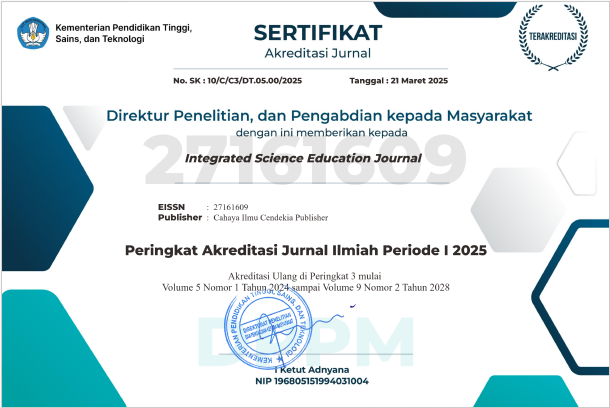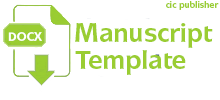Pengaruh Motivasi Belajar Siswa Pembelajaran Fisika SMAN 3 Kota Sungai Penuh Kelas XI MIPA
Abstract
Research Objectives: The purpose of this study was to determine the physics learning ability of students in class XI MIPA SMAN 3 Sungai Penuh, and to motivate students to learn physics.
Methodology: This study uses a quantitative research type with the research subjects of class XI MIPA students of SMAN 3 Sungai Penuh. The data collection instrument was in the form of a student learning motivation questionnaire using google from. Data analysis uses descriptive statistics with the aim of describing the object of research or research results
Main findings: The results showed that basically physics learning at SMAN 3 Sungai Penuh is in class XI MIPA. Because in learning physics students have less interest in learning so that it does not encourage student learning motivation, students will have difficulty in studying physics and cannot connect with concepts. To encourage student motivation, what the teacher must do is ensure students can master the material.
Novelty of the study: After conducting the research, it was found that the novelty of this research is the influence between motivation and student learning outcomes in learning physics at SMAN 3 Sungai Penuh.
References
N. Nehru and E. Irianti, “Analisis hubungan rasa ingin tahu dengan hasil belajar IPA,” J. Pembang. Pendidik. Fondasi dan Apl., vol. 7, no. 1, pp. 53–59, 2020, doi: 10.21831/jppfa.v7i1.25234.
D. A. Kurniawan, A. Astalini, and N. Kurniawan, “Analisis Sikap Siswa Smp Terhadap Mata Pelajaran Ipa,” Lentera Pendidik. J. Ilmu Tarb. dan Kegur., vol. 22, no. 2, p. 323, 2019, doi: 10.24252/lp.2019v22n2i14.
S. A. Utami, M. Hendri, and Darmaji, “Hubungan lingkungan belajar terhadap hasil belajar fisika kelas XI MIA SMA Negeri Muaro Jambi,” EduFisika, vol. 02, no. 02, pp. 58–67, 2017.
D. Darmaji, A. Astalini, D. A. Kurniawan, and R. Perdana, “A study relationship attitude toward physics, motivation, and character discipline students senior high school, in Indonesia,” Int. J. Learn. Teach., vol. 11, no. 3, pp. 99–109, 2019, doi: 10.18844/ijlt.v11i3.4207.
A. Astalini, D. A. Kurniawan, and S. Sumaryanti, “Sikap Siswa Terhadap Pelajaran Fisika di SMAN Kabupaten Batanghari,” JIPF (Jurnal Ilmu Pendidik. Fis., vol. 3, no. 2, p. 59, 2018, doi: 10.26737/jipf.v3i2.694.
D. P. Damanik and N. Bukit, “Analisis Kemampuan Berpikir Kritis Dan Sikap Ilmiah Pada Pembelajaran Fisika Menggunakan Model Pembelajaran Inquiry Training (It) Dan Direct Instruction (Di),” J. Pendidik. Fis., vol. 2, no. 1, pp. 16–24, 2013.
T. Aminoto, R. Dani, and E. Yuversa, “Pengembangan Termometer Gas Sebagai Alat Peraga Pembelajaran Pokok Bahasan Skala Suhu Mutlak,” EduFisika, vol. 4, no. 02, pp. 48–55, 2019, doi: 10.22437/edufisika.v4i02.7636.
W. R. Saputra, M. Hendri, and T. Aminoto, “Korelasi Motivasi Dan Hasil Belajar Ipa Siswa Kelas Viii Di Smp Negeri Se-Kecamatan Jambi Selatan,” EduFisika, vol. 4, no. 01, pp. 36–45, 2019, doi: 10.22437/edufisika.v4i01.3996.
M. Huda, “Kompetensi Kepribadian Guru Dan Motivasi Belajar Siswa (Studi Korelasi Pada Mata Pelajaran Pai),” J. Penelit., vol. 11, no. 2, pp. 237–266, 2018, doi: 10.21043/jupe.v11i2.3170.
R. Dani, N. A. Latifah, and S. A. Putri, “Penerapan Pembelajaran Berbasis Discovery Learning Melalui Metode Talking Stick Untuk Meningkatkan Pemahaman Konsep Gerak Lurus,” EduFisika, vol. 4, no. 02, pp. 24–30, 2019, doi: 10.22437/edufisika.v4i02.6058.
D. Oktaviana, Jufrida, and Darmaji, “Penerapan RPP Berbasis Multiple Intelligences untuk Meningkatkan Aktivitas dan Hasil Belajar Fisika Siswa pada Materi Kalor dan Perpindahan Kalor Kelas X MIA 4 SMA Negeri 3 Kota Jambi,” J. EduFisika, vol. 1, no. 1, pp. 7–12, 2016.
Arikunto, Suharsimi. (2010). Prosedur Penelitian Suatu Pendekatan Praktik. Jakarta: Rineka Cipta
Copyright (c) 2022 Tinur Hasibuan

This work is licensed under a Creative Commons Attribution-NonCommercial 4.0 International License.
Authors who publish with this journal agree to the following terms:
- Authors retain copyright and acknowledge that the Integrated Science Education Journal is the first publisher licensed under a Creative Commons Attribution 4.0 International License.
- Authors are able to enter into separate, additional contractual arrangements for the non-exclusive distribution of the journal's published version of the work (e.g., post it to an institutional repository or publish it in a book), with an acknowledgment of its initial publication in this journal.
- Authors are permitted and encouraged to post their work online (e.g., in institutional repositories or on their website) prior to and during the submission process, as it can lead to productive exchanges and earlier and greater citation of published work.







.png)
.png)






